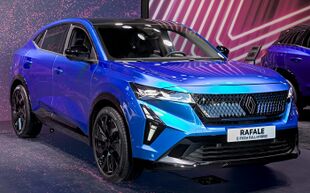Engineering:Renault Rafale
| Renault Rafale | |
|---|---|
 | |
| Overview | |
| Manufacturer | Renault |
| Production | 2024 (to commence)[1] |
| Assembly | Spain: Palencia (Renault España) |
| Designer | Marco Brunori, Yang Fu, Pierre Sabas, Bertrand Grisard |
| Body and chassis | |
| Class | Mid-size crossover SUV (D) |
| Body style | 5-door coupe SUV |
| Layout | Front-engine, front-wheel-drive |
| Platform | Renault–Nissan CMF-CD |
| Related | Renault Austral Renault Espace |
| Powertrain | |
| Engine | |
| Transmission | MultiMode automatic transmission |
| Hybrid drivetrain | Full hybrid Plug-in hybrid |
| Battery |
|
| Dimensions | |
| Wheelbase | 2,740 mm (107.9 in)[2] |
| Length | 4,710 mm (185.4 in)[2] |
| Width | 1,860 mm (73.2 in)[2] |
| Height | 1,610 mm (63.4 in)[2] |
| uk|uk|Kerb|Curb}} weight | 1,653 kg (3,644 lb) |
The Renault Rafale is a mid-size crossover SUV in coupe SUV form that will be produced by French manufacturer Renault from 2024. Built upon the recently-established Renault–Nissan CMF-CD, it shares about 75 percent of its parts and design features with the SUV Espace and Austral models.[3]
Codenamed 'DHN', the vehicle is the second coupe SUV produced by the brand after the Arkana compact crossover. In Renault's lineup, the vehicle is positioned between the Arkana and the slightly larger Espace V.[4]
The Rafale is named after the C.460 Rafale monoplane introduced in 1934 by the Caudron-Renault aviation company, although the name was also used more recently on the Dassault Rafale fighter jet.[5][6]
Overview
The vehicle is 4,710 mm (185 in) long, meaning it belongs to the British D-segment size segmentation, and will have a full hybrid and a plug-in hybrid available.
The Rafale received a new plug-in hybrid powertrain with 300 hp (220 kW) and all-wheel drive by installing an electric motor at the rear.[6] Despite being smaller than the Espace, the Rafale is still considered the flagship for the brand.[7]
Powertrain
Available in both hybrid and plug-in hybrid options, the hybrid model includes two motors which drive both front wheels for a FWD layout. The two motors, which one produces 51 kW (68 hp; 69 PS) and the other produces 25 kW (34 hp; 34 PS), makes a combined output of 149 kW (200 hp; 203 PS). The PHEV model includes two motors at each axle for an AWD layout. The motors create a combined output of 224 kW (300 hp; 305 PS) and 450 N⋅m (45.9 kg⋅m; 332 lb⋅ft).[8]
| Type | Model | Engine code | Displacement | Power | Torque | Combined system output | Electric motor | Battery | Top speed | 0–100 km/h (0–62 mph) | Transmission | Layout | Production |
|---|---|---|---|---|---|---|---|---|---|---|---|---|---|
| Petrol full hybrid | 1.2 E-Tech | HR12 | 1,199 cc (73.2 in3) I3 turbo | Engine: 97 kW (130 hp; 132 PS)
Motor 1: 51 kW (68 hp; 69 PS) Motor 2: 25 kW (34 hp; 34 PS) |
Engine: 205 N⋅m (20.9 kp⋅m; 151 lb⋅ft)
Motor 1: 205 N⋅m (20.9 kp⋅m; 151 lb⋅ft) Motor 2: 50 N⋅m (5.10 kp⋅m; 36.9 lb⋅ft) |
149 kW (200 hp; 203 PS) | - | 400 V, 2 kWh lithium-ion | N/A | N/A | MultiMode automatic | FWD | |
| 2024–present | |||||||||||||
| Petrol plug-in hybrid | 1.6 PHEV | N/A | 1,598 cc (97.5 in3) I3 turbo | N/A | N/A | 224 kW (300 hp; 305 PS) / 450 N⋅m (45.9 kp⋅m; 332 lb⋅ft) | - | 9.8 kWh | 210 km/h (130 mph) | 5.8 s | N/A | AWD | |
| 2024–present |
References
- ↑ "The Renault Rafale has landed, and gets a high-performance variant". https://www.topgear.com/car-news/electric/renault-rafale-has-landed-and-gets-high-performance-variant.
- ↑ 2.0 2.1 2.2 2.3 Pappas, Thanos (June 18, 2023). "2024 Renault Rafale Is Brand's New Flagship Coupe-SUV With Up To 296 HP". https://www.carscoops.com/2023/06/new-renault-rafale-coupe-suv-details-unveiling/.
- ↑ "The All New Renault Rafale". https://www.press.renault.co.uk/en-gb/models/rafale.
- ↑ "TOUCHDOWN AS RENAULT DEBUTS NEW COUPE-STYLED RAFALE SUV". https://www.graaffreinetadvertiser.com/Motoring/Article/Local-Motoring/touchdown-as-renault-debuts-new-coupe-styled-rafale-suv-202306200535.
- ↑ Pappas, Thanos (2023-05-16). "Renault Rafale Is An Austral-Based Hybrid Coupe-SUV, Debuts On June 18". Carscoops. https://www.carscoops.com/2023/05/renault-rafale-is-an-austral-based-hybrid-coupe-suv-debuts-on-june-18/.
- ↑ 6.0 6.1 "2024 Renault Rafale Coupe-SUV Debuts With 300 Horsepower". June 18, 2023. https://www.motor1.com/news/672530/2024-renault-rafale-debut-specs/.
- ↑ "Taking flight: 2024 Renault Rafale debuts as brand's new mid-size SUV flagship, but will it come to Australia?". https://www.carsguide.com.au/car-news/taking-flight-2024-renault-rafale-debuts-as-brands-new-mid-size-suv-flagship-but-will-it.
- ↑ "Renault Rafale: A French Revolution in SUVs". https://www.cardivision.com/renault/renault-rafale-french-revolution-suvs.
 |



